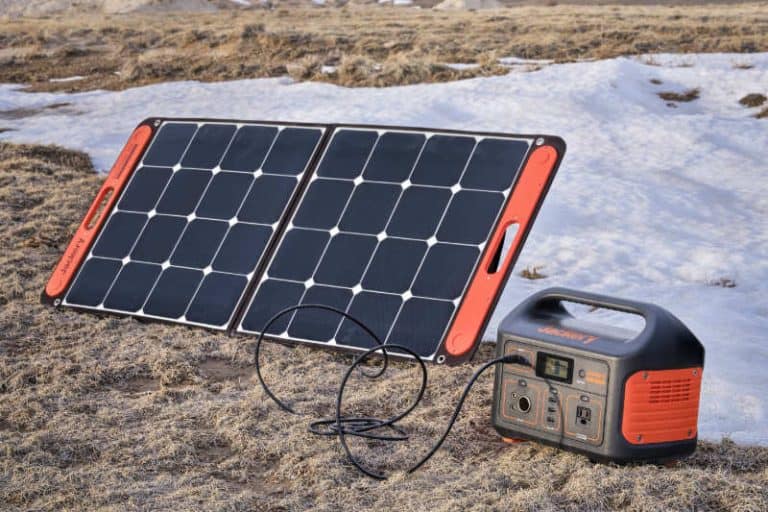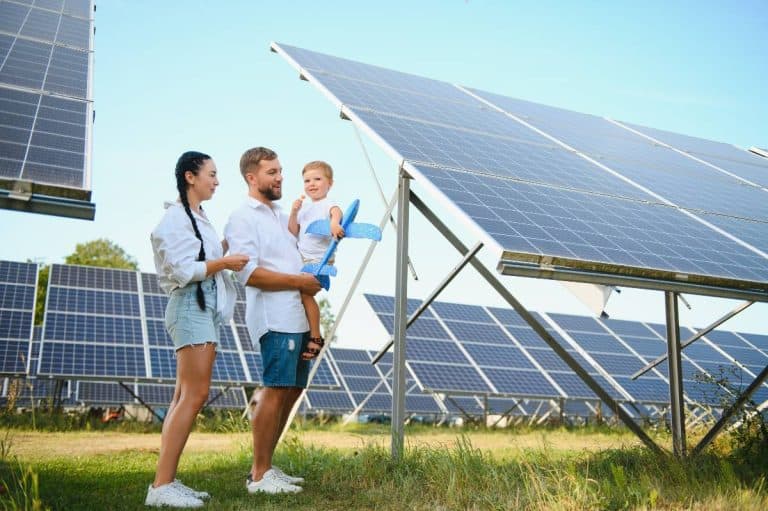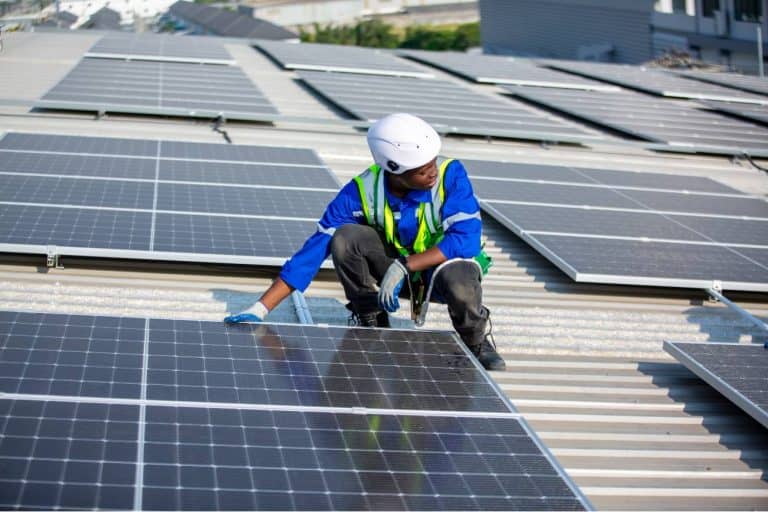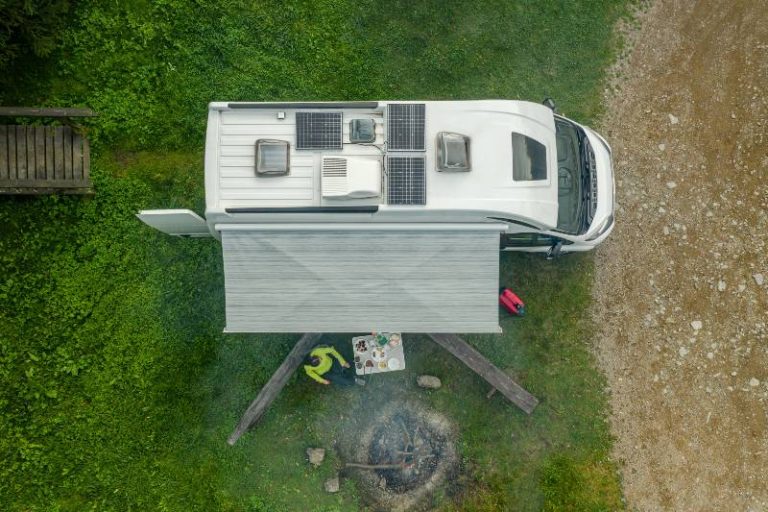Free Energy on the Road: Portable Solar Panels for RV
Do you love traveling with your RV, but dread the downtime at campgrounds and other sites without access to a power hookup? Portable solar panels are an excellent way to keep the batteries in your RV charged so that you can stay on the road and be less dependent on traditional sources of electrical energy.
In this article, we’ll discuss how portable solar panels are helpful when it comes to powering up your recreational vehicle; examples of popular options for the best portable solar panels and charging systems; as well as tips on selecting and installing one in your recreational vehicle. By opting into this source of clean renewable energy, you won’t have to worry about being tethered by cords or running out of power — ever! Read along and find out how portable solar panels for RV can help make sure that you always get from point A to B unscathed.
To ensure your RV’s battery capacity is met, look no further than solar panels! As a rule of thumb: for every 100 Amp Hours (AH) of battery storage that you have on-board, 300 watts worth of solar panel power will do the trick. For example – if your batteries build up to 200 or 250 AH combined between 12 volts systems, the 600-watt solar output should keep things running smoothly.
Key Takeaways
- Portable solar panels are an excellent way to keep the batteries in your RV charged.
- Consider factors such as wattage capacity and size when selecting a portable solar panel.
- Installation of your RV’s portable solar system should be done carefully in order to ensure optimal performance. Be sure to use the appropriate cables and connection adapters for your specific setup.
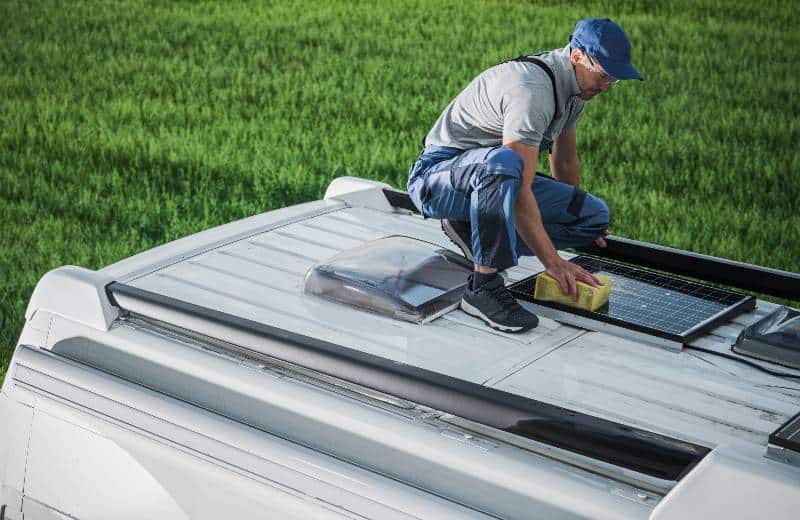
Why Portable Solar Panels are Essential for RV Owners
Reduced reliance on traditional energy sources
Portable solar panels are essential for RV owners, who can use them to reduce their reliance on traditional energy sources.
RVs are designed to be mobile and self-sufficient. You can take your home with you wherever you go—but if you want to enjoy the full benefits of your home on wheels, it’s important to be prepared for any situation. And this means making sure that your RV is equipped with everything it needs to function without relying on traditional energy sources.
In fact, one of the most common ways people use their RVs is as a temporary home while they travel or camp somewhere else—but these trips are often short-term, so having access to battery power for running lights and appliances can be difficult. Portable solar panels allow RV owners to make sure they have enough power at all times by charging batteries from sunlight instead of gas stations or electricity grids.
Cost savings in the long run
The cost of portable solar panels is a bit more upfront than the price of a generator. But with the savings you get from not having to buy fuel, they’ll pay for themselves in no time.
It’s also important to remember that generators aren’t always available when you need them. Even if you have one on hand, it’s probably not going to fit in your RV storage. Solar panels are a much more sustainable option that will never let you down when you need them most.
Increased freedom and flexibility in RV travel
Being able to camp wherever you want, whenever you want, has always been a dream of many RV owners. But it’s one that hasn’t been easy to realize with the limited resources available on the road. That’s where portable solar panels come in. By giving you the power to generate your own electricity while traveling, portable RV solar panels can help you experience the freedom and flexibility that comes with off-grid living—without leaving behind all of the comforts of home.
Reduced environmental impact
If you’re an RV owner, you know that the environment is important to you. You want to do everything you can to reduce your environmental impact while enjoying your time in nature and on the road.
That’s why portable solar panels are so essential. They provide an easy way for RV owners to charge their batteries without using fossil fuels or polluting the air around them. You can use portable solar panels to power your devices, charge your car battery, run appliances—even run your refrigerator! And with different types of portable solar panels available, there’s a solution for every situation.
How to Choose the Right Portable Solar Panel for Your RV
Wattage and output requirements
Choose the wattage you require to run your appliances and devices. Will you only use solar panels to power your laptop, tablet, or phone, or will you use them to power your entire RV?
Typically, portable RV panels range in power from 100W to 400W.
It is advisable to get panels with more than 100 watts if you plan to have portable panels to power a full RV. But remember that heavier panels have greater wattage.
A complete RV may be powered by portable power units, A 100W panel with USB ports also allows you to directly charge your phone or tablet without the use of any additional clips or accessories.
Size and weight considerations
Selecting the right portable solar panel for your RV can be a crucial decision, as it will greatly impact the efficiency of your power supply during your trips. Considering the size and weight of the solar panel is essential in making an ideal choice.
A professional, friendly, and easy-to-understand approach can streamline this process for you. When deciding on a portable solar panel, take into account the available space on your RV’s roof, as well as the panel’s potential impact on your vehicle’s weight distribution.
Opt for a lightweight and compact panel that is compatible with your RV’s size, ensuring that it can be easily transported and installed without hindering your driving experience. Besides, it is wise to seek expert advice or read recommendations from fellow RV enthusiasts to ensure you are investing in a solar panel that best suits your specific energy needs and budget.
Durability and portability features
Selecting the ideal portable solar panel for your RV involves a careful evaluation of both durability and portability features, ensuring that your investment delivers reliable and long-lasting performance.
As you embark on your RV adventures, it’s crucial to have confidence in your solar panel’s ability to withstand varying weather conditions and physical impacts. Seek out high-quality materials and robust construction, as well as weather-resistant qualities like UV- and water-resistance.
Also, portability plays a significant role, as you’ll need to effortlessly transport, set up, and store the solar panel throughout your journey. Opt for lightweight designs with foldable or compact structures and user-friendly installation, maximizing space efficiency and minimizing hassle.
By combining these essential features, your solar panel system will offer the perfect balance of resilience and adaptability, powering your RV expeditions with ease and convenience.
Cost and value for money
Finding the right portable solar panel for your RV is essential for enjoying the benefits of solar energy while on the go. To ensure you make the best choice, it’s crucial to strike a balance between cost and value for money.
As a wise RV owner, you want to invest in a solar panel that provides reliable energy, is durable, and is easy to install and maintain—all without breaking the bank.
To achieve this, begin by conducting thorough research on various brands and models, comparing their efficiency, output, and warranty. Reading reviews from other RV users who have tried and tested these products can offer invaluable insights. Also, it’s essential to assess your specific energy needs, helping you determine the ideal size and capacity.
How to Install Portable Solar Panels on Your RV
Tools and materials needed
1. Digital Multimeter
Integrating portable solar panels into your recreational vehicle (RV) system can significantly enhance your camping experience, providing a sustainable and reliable power source for all your adventures.
Before you begin the installation process, it is crucial to gather the appropriate tools and materials, which will facilitate a seamless and efficient project.
One indispensable piece of equipment is a digital multimeter, a versatile and user-friendly instrument that can accurately measure different aspects of your solar panel’s performance, including current, voltage, and resistance.
According to Eco Peanut, having a digital multimeter at your disposal not only allows you to verify the quality of electricity being produced by your photovoltaic system but also helps in maintaining and repairing your solar panels, ensuring their longevity and effectiveness throughout your journeys.
2. Battery-Operated Drill
In the world of solar panel installation, the value of a reliable and efficient tool cannot be overstated. Surprisingly, many professionals in the field continue to rely on corded drills, despite the numerous advantages that battery-operated drills offer.
These portable powerhouses are capable of handling all necessary drilling tasks on the roof and significantly reducing the risk of falls by eliminating the cumbersome power cord.
According to Your Energy Blog, embracing the convenience and effectiveness of battery-powered drills can greatly improve the overall work experience for solar panel installers, streamlining their daily tasks and bolstering safety measures.
4. Flat Pry Bar
If you’re installing solar panels, you’ll need a flat pry bar to help tuck the flashing beneath your roof’s shingles. That way, the mounts are securely attached either directly to the roof or hidden under its tiles. All that is left for you to do is position your mount in place and slide in the flashing before securing it with screws. Then add on those all-important rails!
5. Screwdrivers
Your screwdriver set is a necessity during the solar panel installation process, as they are required to securely mount the panels onto your roof. At first, you’ll need them to tightly attach the mounts with their respective screws. Later on, in the wiring part of things, you’ll be glad for having those same screwdrivers at hand!
Mounting options and considerations
Embarking on an adventure in your RV offers a sense of freedom and exploration, but ensuring you have efficient energy sources is crucial for a comfortable journey. Incorporating solar panels into your setup is an eco-friendly and cost-effective solution.
However, it’s essential to consider the mounting options for your unique RV, since different styles and models may present various challenges.
For instance, the sleek curves of an Airstream may require a more meticulous mounting solution. With a bit of research, planning, and understanding, you’ll be able to select and install the ideal solar panel system tailored to your vehicle, seamlessly enhancing your off-grid experiences, while prioritizing environmentally-conscious energy alternatives.
Safety precautions and best practices
- Determine the Energy Needs: Before buying a solar panel kit, calculate the energy requirements of your RV to determine how many watts of solar panels you need. Consider the appliances and devices you will be running, as well as the duration of your trips.
- Mount the Panels: Choose a suitable location to mount the panels. The roof is the most common location, as it provides an unobstructed view of the sun. Use the mounting brackets and sealant to secure the panels to the roof. Ensure that the panels are facing in the right direction and angle for maximum sun exposure.
- Install the Charge Controller: The charge controller regulates the amount of energy that goes into the battery. Install it near the battery and connect it to the solar panels using the appropriate cables.
- Install the Battery Monitor: The battery monitor helps to keep track of the battery’s charge level. Install it near the charge controller and connect it to the battery using the appropriate cables.
- Connect the Battery: Connect the battery to the charge controller using the appropriate cables. Ensure that the positive and negative terminals are correctly connected.
- Test the System: After completing the installation, test the system to ensure that it is working correctly. Monitor the battery level, and check that the solar panels are generating the expected amount of power.
To wrap up, following safety precautions and best practices is crucial when installing portable solar panels on your RV to ensure a safe and successful installation.
How to Maintain Your Portable Solar Panels for Maximum Efficiency
Cleaning and upkeep tips
Maintaining your portable solar panels at peak efficiency is vital for harnessing the maximum amount of energy from the sun, and it’s easier than you might think. One essential aspect is cleanliness, as excess dirt or other substances can obstruct sunlight and reduce efficiency.
Luckily, you can usually clean your panels gently and effectively by using water and a soft sponge or washcloth. If water alone doesn’t suffice, a mild dish detergent and soft-bristled brush should do the trick.
Keep in mind, though, that most solar panel systems typically require cleaning just once or twice a year. By implementing these basic upkeep tips and regularly inspecting your most efficient solar panels for damage, you can enjoy their full potential while keeping your renewable energy source in excellent condition.
Storage and transportation considerations
Maintaining your portable solar panels for maximum efficiency is crucial for those who rely on these renewable energy sources for their power needs.
Ensuring that your panels receive proper ventilation is key, as this helps to regulate the temperature of the internal components, especially when they are charging under direct sunlight. It is also essential to keep the panels protected when not in use, but avoid covering them with blankets or placing them in enclosed spaces where airflow may be limited.
Should your portable power station go unused for more than three months, it’s good practice to discharge the battery to 0% and then recharge it fully to 100%. This helps to prevent calibration errors that can arise when the device is left idle for an extended period.
Last but not the least, when storing your portable solar panels for the long term, make sure the battery charge is maintained between 30%-60%, as this will enhance the overall lifespan and efficiency of the device. Remember, proper care and attention go a long way in ensuring your portable solar panels continue to provide optimal performance.
Troubleshooting common issues
Step 1: Verify the Breaker Switches
It may be surprising, but a tripped breaker switch can often be the culprit behind most solar panel issues. As such, when attempting to troubleshoot problems with your solar panel system, checking the breaker switches should be one of your first steps. Overloads, surges, or glitches can trigger the switch, which can prevent the system from producing electricity and supplying it to your appliances.
Step 2: Check for Obstructions
Shading can significantly impact the performance and output of your solar panels. It’s essential to ensure that the panels are receiving direct sunlight and that there are no obstructions in front of them. Possible obstructions include tree shade, building shade, shading from adjacent panels, accumulated dirt and debris, animal droppings, and more.
Step 3: Inspect the Solar Inverter
Every photovoltaic (PV) system has a solar inverter, which is a crucial component that converts generated DC power into usable AC power. Poor connections to the inverter or its absence can also result in zero power output. Check the inverter and observe its light color, which can be green, yellow, red, or flashing. Green indicates it’s okay, while other colors may suggest a problem. If unsure, seek the services of a solar technician.
Step 4: Monitor Your Solar Meter
Solar meters accumulate historical data on energy generation by your solar panels, providing insight into your system’s performance. Any decrease in output over time may indicate an issue with your solar panel system. Comparing past data with present data can also help detect any anomalies.
Long-term maintenance strategies
Solar panels are an excellent investment that can provide clean energy for your home or RV for many years. To ensure that your solar panels continue to operate efficiently and generate maximum power output over their lifespan, you need to adopt a long-term maintenance strategy. Here are some key strategies for maintaining your solar panel system:
- Inspect for Damage: Inspect your solar panels regularly for any signs of damage or wear and tear, such as cracks, scratches, or loose connections. If you notice any damage, replace or repair the affected parts promptly.
- Monitor Performance: Keep track of your solar panel system’s performance by monitoring your energy output using a solar monitoring app or a monitoring system provided by your solar panel manufacturer. If you notice a drop in output, it could indicate a problem with your solar panel system.
- Check Electrical Connections: Inspect the electrical connections of your solar panel system, including the wiring, charge controller, and inverter, for any signs of damage, corrosion, or loose connections. Tighten any loose connections and replace any damaged or corroded components.
- Maintain Battery Bank: If your solar panel system is connected to a battery bank, maintain the batteries by checking the water levels and charging them regularly.
- Perform Annual Inspections: Schedule an annual inspection of your solar panel system with a licensed electrician or solar panel technician to ensure that all components are functioning correctly and identify any potential problems before they become more serious.
By following these long-term maintenance strategies, you can ensure that your solar panel system continues to operate efficiently and generate clean energy for many years.
Top Portable Solar Panels for RVs in 2023
Renogy 300 watts 12 Volts Monocrystalline Solar RV Kit
The Renogy 300 watts 12 Volts Monocrystalline Solar RV Kit is an exceptional portable solar panel system for RVs. It is difficult to find a kit that can compete with the features of this package offered by Renogy.
With an average rating of 4.7 stars on consumer review platforms, this kit includes everything necessary to start building your solar panel system.
The package includes three 100-watt monocrystalline solar panels with an impressive efficiency rate of 22%. These panels are built to withstand winds up to 140 mph and come with 30-foot weather-resistant cables and connectors. The kit also features a 30-amp PWM charge controller and a Bluetooth module that enables remote control and battery voltage monitoring.
This system is expandable and capable of producing electricity at an impressive 90% efficiency rate after 10 years of use. The Renogy kit is also designed to function efficiently in cold weather, with a PMAX temperature coefficient of just .37% per Celsius degree.
HQST 100 watt 12Volt Polycrystalline Solar Panel
While monocrystalline solar panels usually outshine their polycrystalline counterparts in terms of efficiency, HQST’s current poly offering is an exception. The company’s 100 Watt 12 Volt Polycrystalline Solar Panel delivers impressive performance at an unbeatable price point.
With a 4.6-star rating from Amazon customers, the panel measures just over two feet by three feet and boasts an 18.6% efficiency rating. Despite its lightweight construction, the panel is highly resistant to wind and heavy snow loads. It features weather-resistant connections and a temperature coefficient of only .39 per degree Celsius, surpassing many higher-priced competitors’ models.
HQST also offers a five-year panel warranty, proving its commitment to delivering a high-quality product.
Eco-Worthy 100-watt 12 Volt Solar Panel Kit
The Eco-Worthy 100 Watt 12 Volt Solar Panel Kit is ranked next on our list, which stands out as the most affordable monocrystalline panel kit in our review while maintaining an impressive average of 4.4 stars from Amazon consumers. This kit from Eco-Worthy competes with some of the best options available on the market.
The package includes a 21% efficient monocrystalline solar panel, a 30-Amp PWM solar charge controller that is compatible with almost all types of batteries, a robust aluminum frame with pre-drilled mounting holes, weather-resistant cables, and installation hardware. The panel comes with a two-year warranty and features a sleek, slim design that can withstand high wind, heavy snow, or hail loads.
Pro tip: Make sure to read this article that provides you with 15 Must-Have Pieces of Solar Survival Gear to be prepared for anything. Knowing what to have on hand when the lights go out is essential! With the right solar-powered tools, you can be ready for anything that comes your way. Get informed and stay safe with our comprehensive guide. Stay prepared no matter the situation!
Portable Solar Panels For RV FAQs
How do I maintain my portable solar panels for my RV?
To ensure your RV’s solar panels remain in top shape, it’s important to perform regular maintenance. Ensure that all connections are tight, clean the solar panel surface regularly, and check for any signs of wear or damage. Additionally, schedule an annual inspection with a licensed technician to identify any potential problems before they become serious.
Can I use portable solar panels for my RV during the winter months?
When RV camping in winter, solar panels remain highly effective. Solar energy functions similarly to mobile phones and computers; overheating does not improve its performance. In fact, colder temperatures actually boost the output power of solar panels.
How much do portable solar panels cost?
The cost of portable solar panels for RVs can vary widely depending on the components included in the package. Generally, you can expect to pay anywhere from $200 to over $1000 for a quality kit.
How long do portable solar panels last?
While the portable solar industry generally estimates an average lifespan of 25 years for their panels, if you take good care of them and have a low energy usage rate, your flexible solar panels can actually last much longer than that. With adequate maintenance, it’s possible to extend their life expectancy beyond the stated 25-year mark.
Conclusion
By opting for a portable solar panel system on your RV, you can harness the natural benefits of the sun to take your journey further. From reducing noise pollution and leaving a minimal carbon footprint to major cost savings in the long term, investing in an RV solar power system can open up new possibilities as you explore the outdoors.
With the camping season fast approaching now is the time to look into all of your various RV solar systems options. Whether you’re an avid outdoor enthusiast or a first-time camper, these tips can get you started on finding the right RV solar power solution for you.
So don’t wait any longer – take charge of your energy needs and reap the rewards today! Remember if you have any questions about portable solar systems or panels for RVs, visit our website or subscribe to our newsletter for more electric living updates!

